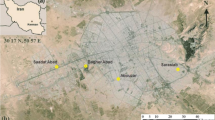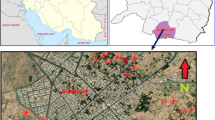Abstract
Purpose
Trace element pollution in soil has become an increasingly common issue and potentially harms the environment and human health. In this study, the contamination levels and ecological and health risk indices of trace elements in surface soils in Bai Cheng, Xin Jiang, were investigated in order to examine if the land usage changed from pasture to agriculture has influenced the behaviours of these trace elements.
Material and methods
In this study, descriptive analysis, normality test, the Tukey-HSD method and non-parametric methods were used to investigate the characteristics of trace elements. The geo-accumulation pollution and ecological risk indices were used to analyse the degree of contamination by trace elements. Correlation and principle analyses were used to identify the sources of trace elements and a health risk assessment was used to analyse human exposure to trace elements of the soil.
Results and discussion
Cadmium was the main pollutant in the 0–5 cm soil layer in both agricultural and pastoral areas. Thus, it contributed most to the Geo-Accumulation Index (Igeo) and the comprehensive potential ecological risk index (RI) of the surface soils. The levels of RI for the topsoil layer of agricultural areas fell into moderate to high (II-III) ecological risk categories, and those of pastoral areas belonged to low to moderate risk categories (I-II). Both values of Igeo and RI of the surface soils in agricultural areas were higher than in pastoral areas. The carcinogenic risk of Cr through hand-to-mouth intake and the total risk of trace elements in soils for humans were higher than the safety reference level. Chromium was the greatest contributor to total carcinogenic risk.
Conclusions
Trace element concentration levels in surface soils in pastoral areas were relevant to geochemical characteristics and atmospheric deposition, whereas trace element concentration levels in surface soils in agricultural areas were derived not only from geochemical characteristics but also from human activities. The change in land use from pasture to agriculture increased the trace element concentration level in surface soils. There were both ecological risks and human health implications for residents exposed to such contaminants of soils in the studied region.





Similar content being viewed by others
References
Abbas Q, Yousaf B, Liu G, Zia-ur-Rehman M, Ali MU, Munir MAM, Hussain SA (2017) Evaluating the health risks of potentially toxic elements through wheat consumption in multi-industrial metropolis of Faisalabad, Pakistan. Environ Sci Pollut Res 24(34):26646–26657
Amorosi A et al (2014) Fingerprinting sedimentary and soil units by their natural metal contents: a new approach to assess metal contamination. Sci Total Environ 500:361–372
Chen HY, Yuan X, Li T, Hu S, Ji J, Wang C (2016) Characteristics of heavy metal transfer and their influencing factors in different soil-crop systems of the industrialization region, China. Ecotox Environ Saf 126:193–201
Chen D, Chen H, Zhao J, Xu Z, Li W, Xu M (2020) Improving spatial prediction of health risk assessment for Hg, As, Cu, and Pb in soil based on land-use regression. Environ Geochem Health 42(5):1415–1428
Cheng L (2009) Evaluation of the potential regional land resource based on GIS—a case study of Baicheng Xinjiang University
Doabi SA, Karami M, Afyuni M, Yeganeh M (2018) Pollution and health risk assessment of heavy metals in agricultural soil, atmospheric dust and major food crops in Kermanshah province, Iran. Ecotox Environ Saf 163:153–164
Environmental Minister of China (2010) Exposure factors handbooks of Chinese population. China Environmental press, China
Epa A (2004) Risk assessment guidance for superfund. Volume I: Human health evaluation manual (Part E, Supplemental Guidance for Dermal Risk Assessment). EPA/540/R/99, Washington, DC
Gray CW, Yi Z, Munir K, Lehto NJ, Robinson BH, Cavanagh JAE (2019) Cadmium concentrations in New Zealand wheat: effect of cultivar type, soil properties, and crop management. J Environ Qual 48(3):701–708
Jiang Y, Chao S, Liu J, Yang Y, Chen Y, Zhang A, Cao H (2017) Source apportionment and health risk assessment of heavy metals in soil for a township in Jiangsu Province, China. Chemosphere 168:1658–1668
Li Q (2017) Study on heavy metal pollution of surface soil and crops in the north slope of Tianshan Mountain [D]. PhD thesis of the Shihezi University
Liu S (2014) Analysis of the pollution problem in xinjiang agricultural production areas [D]. Master thesis of Xinjiang Agricultural University
Liu JJ et al (2015) Heavy metals contents and speciation in surface sediments from Gansu, Ningxia and Inner Mongolia sections of the Yellow River of China. Spectrosc Spect Anal 35(10):2963–2969
Liu Z, Yang Y, Bai Y, Huang Y, Nan Z, Zhao C, Ma J, Wang H (2016) The effect of municipal sludge compost on the mobility and bioavailability of Cd in a sierozem-wheat system in an arid region northwest of China. Environ Sci Pollut Res 23(20):20232–20242
Liu RQ, Bao K, Yao S, Yang F, Wang X (2018) Ecological risk assessment and distribution of potentially harmful trace elements in lake sediments of Songnen Plain, NE China. Ecotox Environ Safe 163:117–124
Luo XS, Xue Y, Wang YL, Cang L, Xu B, Ding J (2015) Source identification and apportionment of heavy metals in urban soil profiles. Chemosphere 127:152–157
Mamat Z, Yimit H, JiR ZA et al (2014) Source identification and hazardous risk delineation of heavy metal contamination in Yanqi basin, northwest China. Sci Total Environ 493:1098–1111. https://doi.org/10.1016/j.scitotenv.2014.03.087
Mamut A, Eziz M, Mohammad A et al (2017) Contamination and risk assessment of heavy metals in farmland soils of Baghrash County, Xinjiang. Northwest China. Sci Cold Arid Reg 9(5):467–475. https://doi.org/10.3724/sp.J.1226.2017.00467
Mamut A, Eziz M, Mohammad A (2018) Pollution and ecological risk assessment of hemvy metals in Farmland soils in Yanqi County, Xinjiang, Northwest China. Eurasian Soil Sci 51(8):985–993
Mora A, Mac-Quhae C, Calzadilla M, Sánchez L (2009) Survey of trace metals in drinking water supplied to rural populations in the eastern Llanos of Venezuela. J Environ Manage 90(2):752–759
Pan ZX (2013) Evaluation of the suitibality of urban construction land based on GIS—a case study of Baicheng Xinjiang University
Ramdani M, Elkhiati N, Flower RJ (2009) Lakes of Africa: North of Sahara. In: Likens GE (ed) Encyclopedia of Inland Waters. Academic Press, pp 544–554
Saha N, Rahman MS, Jolly YN, Rahman A, Sattar MA, Hai MA (2016) Spatial distribution and contamination assessment of six heavy metals in soils and their transfer into mature tobacco plants in Kushtia District, Bangladesh. Environ Sci Pollut Res 23(4):3414–3426
Shen ZJ, Chen YS, Zhang Z (2017) Heavy metals translocation and accumulation from the rhizosphere soils to the edible parts of the medicinal plant Fengdan (Paeonia ostii) grown on a metal mining area, China. Ecotoxicol Environ Saf 143:19–27
Si WT, Liu JM, Cai L et al (2015) Health risks of metals in contaminated farmland soils and spring wheat irrigated with yellow river Water in Baotou, China. Bull Environ Contam Toxicol 94(2):214–219. https://doi.org/10.1007/s00128-014-1435-y
Tudi M, Abuduwaili J, Jiang F (2013) Distribution characteristics and source explanation of heavy metal content in soil on the north slope of Tianshan Mountain. Chinese Journal of Eco-Agriculture 3:883–890
Tudi M, Phung DT, Ruan HD, Yang LS, Guo HJ, Connell D, Chu C (2019) Difference of trace element exposed routes and their health risks between agriculture and pastoral areas in Bay County Xinjiang, China. Environ Sci Pollut Res 26(14):14073–14086
Turdi M, Yang LS (2016) Trace elements contamination and human health risk assessment in drinking water from the agricultural and pastoral areas of Bay County, Xinjiang, China. Int J Environ Res Public Health 13(10):938. https://doi.org/10.3390/ijerph13100938
Wang H, Nie L, Xu Y, Lv Y (2017) The effect of highway on heavy metal accumulation in soil in turfy swamps. Northeastern China. Water Air Soil Pollut 228(8):292
Wiggenhauser M, Bigalke M, Imseng M, Müller M, Keller A, Murphy K, Kreissig K, Rehkämper M, Wilcke W, Frossard E (2016) Cadmium isotope fractionation in soil-wheat systems. Environ Sci Technol 50(17):9223–9231
Xie S, Yang F, Feng H, Wei C, Wu F (2019) Assessment of potential heavy metal contamination in the peri-urban agricultural soils of 31 provincial capital cities in China. Environ Manage 64(3):366–380
Yousaf B, Liu G, Wang R, Zia-ur-Rehman M, Rizwan MS, Imtiaz M, Murtaza G, Shakoor A (2016) Investigating the potential influence of biochar and traditional organic amendments on the bioavailability and transfer of Cd in the soil-plant system. Environ Earth Sci 75(5):374
Zeng XX, Liu Y, You S, Zeng G, Tan X, Hu X, Hu X, Huang L, Li F (2015) Spatial distribution, health risk assessment and statistical source identification of the trace elements in surface water from the Xiangjiang River, China. Environ Sci Pollut Res 22(12):9400–9412
Zeng S, Ma J, Yang Y, Zhang S, Liu GJ, Chen F (2019) Spatial assessment of farmland soil pollution and its potential human health risks in China. Sci Total Environ 687:642–653
Zhang Y, Abuduying J, Jiang FQ (2014) Pollution evaluation and ecological risk analysis of heavy metals in surface soil of Tian-Shan Mountain. Chinese Journal of Advance in Earth Sciences 5:608–616
Zhang S, Liu G, Sun R, Wu D (2016) Health risk assessment of heavy metals in groundwater of coal mining area: a case study in Dingji coal mine, Huainan coalfield, China. Hum Ecol Risk Assess 22(7):1469–1479
Zhang H, Jiang Y, Ding M, Xie Z (2017) Level, source identification, and risk analysis of heavy metal in surface sediments from river-lake ecosystems in the Poyang Lake, China. Environ Sci Pollut Res 24(27):21902–21916
Zhang WX, Chen Y, Qi Y, Hong C (2018) Seasonal variations of mercury levels and human health risk in vegetables from Arid Oasis (Shihezi city), Xinjiang, Northwest China. Hum Ecol Risk Assess 24(1):122–136
Zhang ZX, Zhang N, Li H, Lu Y, Wang Q, Yang Z (2019) Risk assessment, spatial distribution, and source identification of heavy metal (loid)s in paddy soils along the Zijiang River basin, in Hunan Province, China. J Soils Sediments 19(12):4042–4051
Zheng J, Chen KH, Yan X, Chen SJ, Hu GC, Peng XW, Yuan JG, Mai BX, Yang ZY (2013) Heavy metals in food, house dust, and water from an e-waste recycling area in South China and the potential risk to human health. Ecotoxicol Environ Saf 96:205–212
Zhu L et al (2017) Deposition behavior, risk assessment and source identification of heavy metals in reservoir sediments of Northeast China. Ecotoxicol Environ Saf 142:454–463
Funding
This study was financially supported by the National Key R&D Program of China (NO. 2018YFC0407502); Science and Technology Project of Beautiful China Ecological Civilization Construction (No. XDA23100403).
Author information
Authors and Affiliations
Corresponding author
Ethics declarations
This article does not contain any studies involving human participants or animals.
Conflict of interest
The authors declare that they have no conflict of interest.
Additional information
Responsible editor: Yongtao Li
Publisher’s note
Springer Nature remains neutral with regard to jurisdictional claims in published maps and institutional affiliations.
Electronic supplementary material
ESM 1
(DOCX 95 kb)
Rights and permissions
About this article
Cite this article
Tudi, M., Ruan, H.D., Wei, B. et al. Ecological and health risk assessment of trace elements in surface soil in an arid region of Xin Jiang, China. J Soils Sediments 21, 936–947 (2021). https://doi.org/10.1007/s11368-020-02812-y
Received:
Accepted:
Published:
Issue Date:
DOI: https://doi.org/10.1007/s11368-020-02812-y




